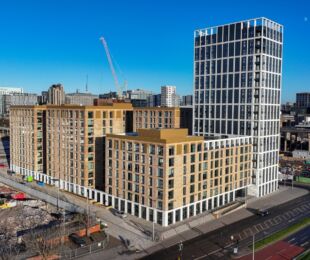
Timekeepers Square is a development of 36 townhouses within the Adelphi and Bexley Square conservation area in Salford by Manchester-based Buttress Architects. Sited adjacent to the grade-II*-listed Greek Revival St Philip’s Church, designed in 1822-24 by Robert Smirke, architect of the British Museum, it forms part of the English Cities Fund’s Salford Central regeneration scheme, which aims to revitalise more than 50 acres of Salford’s historic central district.
The design of the two-, three- and four-bed townhouses draws inspiration from the area’s Georgian terraces, particularly in terms of height and massing, while the elevations feature a vertical emphasis and regular rhythm of fenestration. This is enhanced by deep recesses to the windows and doorsets, which contrast with the otherwise planar facades.
The new terraces are aligned so as to reinstate the quarter’s lost urban grain, strengthening the setting of the church as a focal point and defining a new central pedestrian boulevard, St Philip’s Walk. The public realm has been enhanced with new outdoor spaces, from private ground-floor green spaces and roof gardens to communal spaces and pedestrian, play friendly, high quality, home zone streets. A sketch by celebrated local artist LS Lowry, ‘By St Philip’s Church’, is incorporated as a pavement engraving at the top of St Philip’s Walk.
Buttress Architects’ objective was to remain sensitive to the area’s heritage, yet instill the project with a clear, contemporary identity. As such, a grey brick with a light texture was specified so as to mediate between the red brick of the Georgian houses and the sandstone of the church. The brickwork contributes to the development’s limited material palette, creating homogeneity and a sense of place. The homogeneity is reinforced by the choice of mortar, which is close in colour and tone to the bricks, while the mortar joints are recessed by 3mm to underline the bricks’ tonal variation and provide visual interest. The brick’s handmade quality also provides a domestic, tactile character to the walls, which contrasts to the engineered refinement of the aluminium window frames.
A metal filigree of Juliet balustrades and boundary railings provide a further visual and material foil to the brickwork, while serving to articulate the elevations and resonate with the cast iron railings surrounding the church. Standing-seam zinc roof finishes to the two-storey houses further complement the brickwork and enrich the development’s restrained aesthetic.






